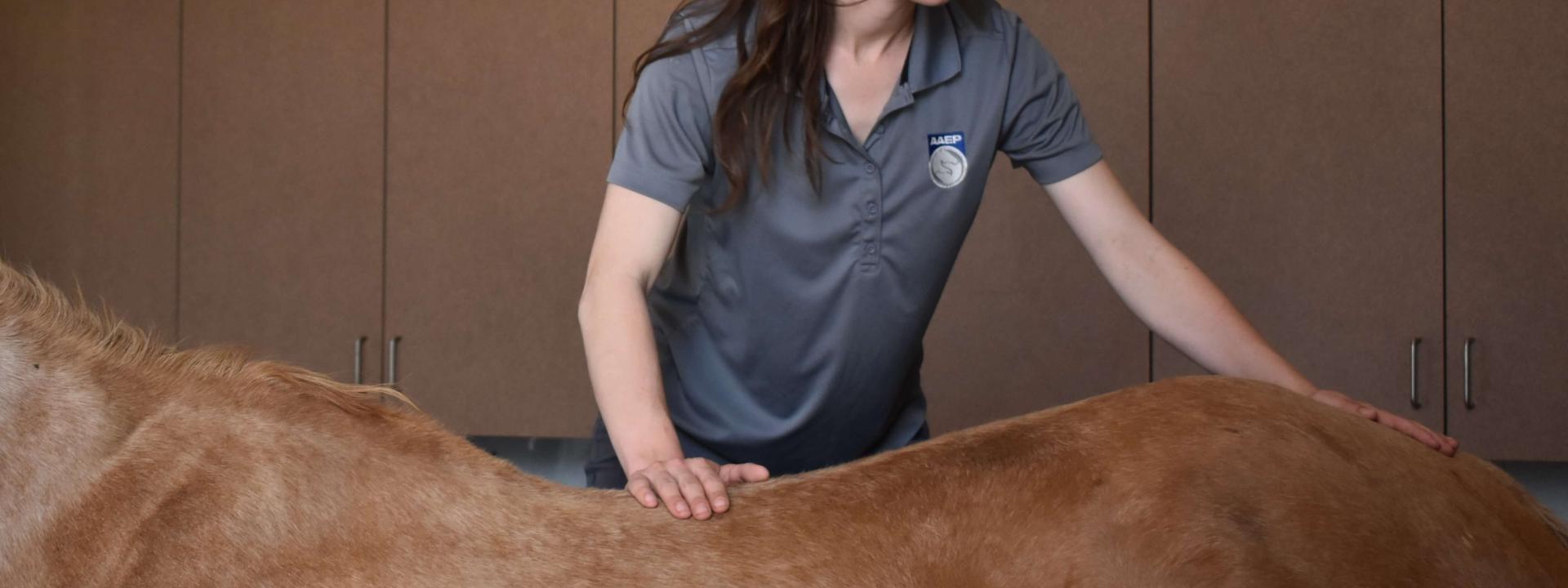What is chiropractic?
Chiropractic is a modality in which the doctor evaluates the motion of the joints in the spine and extremities in order to identify subluxations or aberrant motion. This does not mean that the joint is physically out of its normal range of motion (luxated) although colloquially we often say that a joint is “out” when referring to a subluxation. It simply means that the joint is not moving properly. When the doctor finds these subluxations a high velocity, low amplitude thrust or adjustment is put into the joint to restore proper motion.
Chiropractic originates from the Greek words “cheir” (meaning hand) and praktos (meaning done). As the word suggests chiropractic is both a diagnostic and treatment performed entirely by the doctors’ hands. Although activators (handheld devices used to apply the adjustment) are often commonly used in human chiropractic, no equine specific activators are currently on the market for use in equine chiropractic and therefore the use of an activator is not recommended in equine patients. It may seem difficult to believe that a human can exert enough force to affect an animal as big as a horse but the joints in their spine, known as facets, are actually about the size of ours! This is due to the differences in the way gravity affects us. Whereas humans are bipedal (we walk on two legs) horses are quadrupedal (they walk on four legs). That means that all day our facets are subjected to compressive forces that essentially crush them. Horses on the other hand are subjected to shear forces that pull down across the facet joints rather than crushing them. Therefore a smaller facet is required in relation to the horse’s body size.
The manipulation of joints to improve function and health has been utilized for hundreds to thousands of years but the first documented chiropractic adjustment took place in 1895. It was performed by DD Palmer on a deaf man named Harvey Lillard. Lillard had suffered a trauma years earlier that rendered him deaf. Palmer noted in his exam that Lillard had an odd bump in his spine. When Palmer applied a force to the bump Lillard felt it give way and later his hearing was restored. Palmer went on to open the Palmer College of Chiropractic in 1897 in Davenport, Ohio where it still stands to this day. The first state law officially licensing chiropractors was passed in 1913. Animal chiropractic followed suit primarily forged by Sharon Willoughby, a veterinarian who discovered the magic of chiropractic after a farmer called a chiropractor as a last resort for his down cow. Following the cow’s adjustment she was able to rise. Dr. Willoughby was understandably impressed by this display as traditional veterinary medicine had been unable to help this animal. She wanted to learn more and attended Palmer College of Chiropractic, graduating in 1986. In 1988 she founded the first college for animal chiropractic, Options for Animals, where all of the Tennessee Equine Hospital chiropractic team has gone for their study of the art and science of chiropractic.
How does chiropractic work?
The primary complaint bringing patients to the chiropractor is back pain but chiropractic can do so much more! When thinking about the benefits of chiropractic most people think of the effect on the musculoskeletal system. To be sure, chiropractic can relax muscles, alleviate pain, and improve joint motion and function. But perhaps its greatest asset pertains to neurology. The brain communicates with the body by way of the spinal cord which run through the vertebrae of the spine in the neck and back. From there, nerves branch off the spinal cord and run in between the vertebrae as they make their way to the rest of the body. When the joints in the spine are not moving appropriately the nerves can get pinched as they course through them. This can not only cause pain but also dysfunction in the nerve itself. This can manifest itself in many different ways: immune compromise, infertility, heart, kidney, liver, or GI dysfunction, and decreased conscious proprioception. In sum, chiropractic can treat everything.
Who can benefit from chiropractic?
Everyone! Well, vertebrates. If it has a spine, it can benefit from chiropractic. From giving your newborn foal an immune boost to improving the quality of life of your geriatric pasture ornament and from elite equine athletes to their couch potato counterparts, truly all horses can benefit from chiropractic. Have a horse battling with a chronic disease such as asthma or colic? Try chiropractic. Have a pesky lameness or performance issue no vet can seem to solve? Try chiropractic. Have a mare that you just can’t seem to get pregnant or a stallion that just isn’t as fertile as he used to be? Try chiropractic. (Are you picking up on a theme here?)
Many clients ask us to check their horse to see if they need chiropractic. But the act of checking for subluxations is in fact performing the chiropractic exam itself. And we now know from the previous paragraph that every horse can benefit from chiropractic the question is how often. For horses working through an acute injury or illness chiropractic may need to be performed weekly or every other week until the issue is showing some improvement. For otherwise healthy horses every couple months may suffice. Your chiropractor will work with you and your horse to develop a schedule that works for your unique situation.
Putting it all together.
Here at Tennessee Equine Hospital, we view chiropractic as complementary medicine. It is a wonderful tool that can detect problems at the subclinical level, meaning before they become readily apparent to the owner or even veterinarian. Therefore it can help prevent disease and injury and stave off the need for traditional medical intervention. But it is by no means a replacement for traditional veterinary care. Routine prophylaxis such as feet trimming, teeth floating, vaccines, deworming, and soundness and wellness exams should still be performed regularly and in the event of illness or injury a veterinarian should still be your first call. But chiropractic can enhance those traditional therapies and improve your horse’s overall outcome and performance.
If we have piqued your interest and you want to see what chiropractic can do for you and your four legged friend give us a call today!
Dr. Emily Guest DVM

